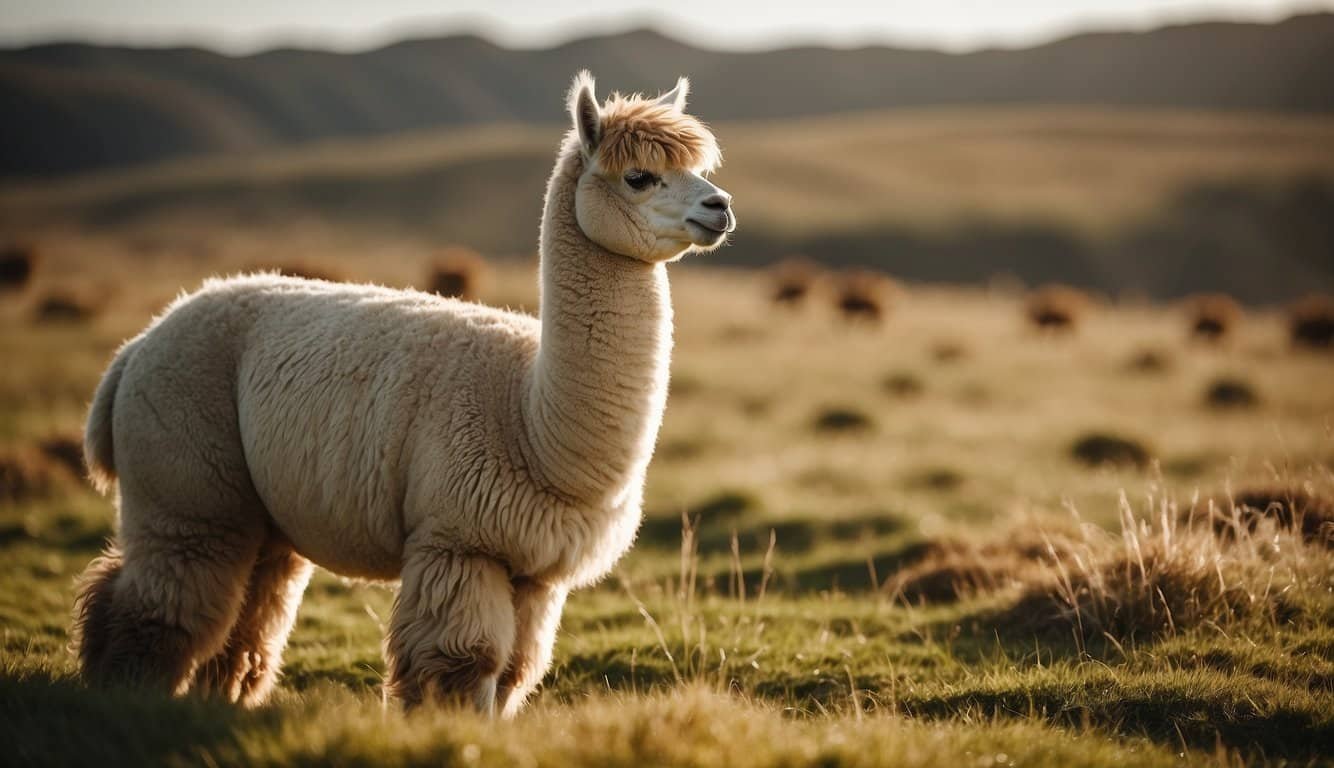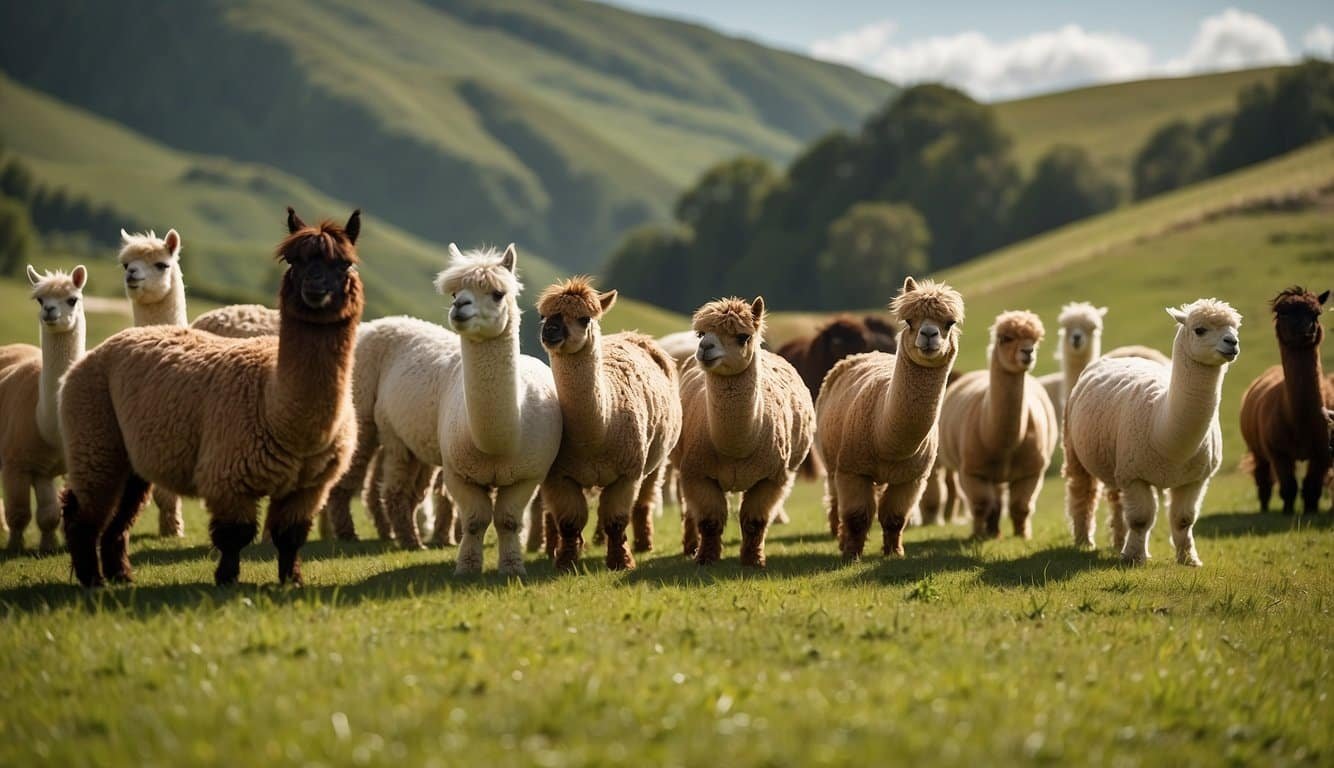Alpaca Origins and Species
Embarking on a journey through the high Andes of South America, one discovers the alpaca, a domesticated treasure with a lineage that whispers tales of pre-Columbian times. Bearing the scientific name Vicugna pacos, alpacas are a testament to the ingenuity of ancient cultures and the rich tapestry of life in the camel family.
Historical Domestication
Alpacas were first domesticated thousands of years ago by indigenous peoples of the Andes, predominantly in what is now Peru. These early herders saw the value in the alpaca for its incredibly soft fleece, ushering in an era of selective breeding which resulted in the gentle, fleece-bearing creatures we know today. This domestication effort has shaped the modern alpaca into a cornerstone of Andean culture and economy.
Related Species Comparison
Alpacas belong to the South American camelid family, sharing a common ancestry with the wild vicuña, their closest relative. In terms of taxonomy, alpacas were once incorrectly dubbed as Lama pacos, but further genetic analysis solidified their standing as Vicugna pacos. They share the camelid lineage with llamas, which are more closely related to another wild ancestor, the guanaco. Interestingly, alpacas and llamas have certain characteristics that suggest hybridization may have occurred between the two domesticated species and their wild cousins, the vicuñas and guanacos, in their evolutionary history.
Alpaca Breeds Varieties
The vast expanse of the Andean highlands is home to two primary alpaca breed varieties: the Huacaya and the Suri. These breeds are distinguished by their fleece: the Huacaya alpaca boasts a crimpy, sheep-like coat, while the Suri alpaca’s fleece falls in elegant, dreadlock-like locks. Breeders in South America and around the globe cherish these breeds for their distinct fibers, which make for luxurious textiles celebrated worldwide. Despite their differences, both breeds share the common qualities that make alpacas especially endearing: their gentle demeanor and curious, expressive faces.
Physical Characteristics and Behavior

Alpacas are notable for their luxuriously soft fleece and highly social nature. These animals from the camelid family boast a fascinating array of physical traits and behaviors adapted to their native environments.
Distinctive Features
Alpacas typically stand at the shoulder between 81 to 99 centimeters (32 to 39 inches) in height, with their weight ranging from 48 to 84 kilograms (106 to 185 pounds). They are characterized by their small heads, long necks, and large, expressive eyes which are framed by lengthy lashes. Their ears are spear-shaped, an adaptation aiding their strong hearing abilities. Alpaca fiber, renowned for its softness and thermal properties, comes in an array of natural colors, including shades of white, brown, gray, and black.
Social Structure and Reproduction
Alpaca herds exhibit a complex social structure, where both males and females have distinct roles. Females typically give birth to one offspring, known as a cria, after a gestation period of roughly 11.5 months. Herds often hum to communicate, and they form strong bonds. Alpaca males assert dominance for breeding rights, whereas females initiate mating with a unique behavioral posture known as “cushing.”
Habitat and Adaptations
Originating from the Andes Mountains, alpacas are well-suited for high altitudes and can thrive in environments as high as 4,800 meters (15,750 feet) above sea level. Their thick fleece protects them from drastic temperature changes, and their padded feet minimize soil disruption, preserving delicate mountain grasses. Diet-wise, alpacas primarily consume grass and hay, which are abundant in their habitat and have adapted their behavior to grazing in sparse vegetation conditions. Their unique digestive system allows them to extract nutrients efficiently from their diet, which is particularly important in the nutrient-poor soils at high altitudes.
Alpaca Farming and Industry

Alpaca farming taps into the unique qualities of alpacas, such as their soft fleece and adaptability to various environments. The alpaca industry has become increasingly important as demand for their luxurious fiber grows worldwide.
Shearing and Fiber Processing
Alpacas, primarily the Huacaya and Suri breeds, are sheared annually for their fleece, prized for its warmth and softness. Post-shearing, the alpaca fiber is processed on special equipment, often designed for sheep’s wool, to create yarn that’s then woven into textiles. The fleece from Huacaya alpacas is crimped, adding to its elasticity, while Suri fleece is known for its luster and drape, making it suitable for higher-end products.
Diet, Health, and Care
Alpacas, domesticated Andean livestock, thrive on a simple diet primarily consisting of grass, hay, and water. They efficiently convert food to energy, which is economical for farmers. Proper nutrition aids in producing quality fleece and maintaining herd health. Their care involves protection from predators and shelter from extreme rain or sun, as adverse conditions could lead to health issues or fleece damage.
Global Distribution and Markets
Originally from the Andean regions of South America, including Bolivia, Ecuador, and Chile, the global population of alpacas is now widespread, with significant numbers in North America and Australia. The international alpaca market is evolving, focusing on breeding and fleece production. Farms vary in scale from small hobby operations to large, commercial ventures where alpacas are bred for their fiber, and in some countries, their meat.

